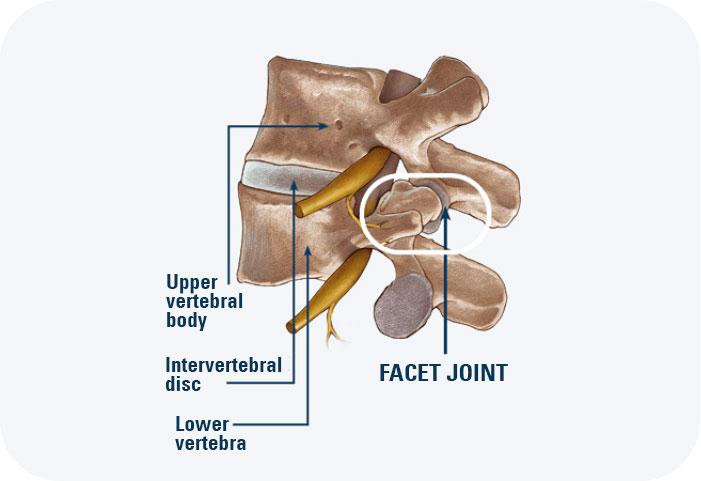Facet Joint Syndrome
Many people suffer from back pain and in the vast majority of cases – around 90% – this pain, which usually occurs acutely, disappears on its own. For the rest, however, it can last for several months, making it chronic back pain. One possible trigger for pain is facet syndrome.
What causes Facet Joint Syndrome?
The facet joints bear a large share of the static load on the spine, but they are subject to even more stress with movements – especially when bending or twisting. There are degenerative processes in the facets similar to those in other joints of the body and therefore osteoarthritis may develop.
Not only the result of the natural spinal aging process but also an accidental injury including whiplash or overuse due to – for example – sports or heavy labor already at a younger age can be the initial cause of arthritis or facet syndrome. In addition, the facet joints’ damage may stem also from excessive weight or family history of facet syndrome.


What are the Symptoms of a Facet Syndrome?
The symptoms of facet syndrome are difficult to define clearly because they are very diverse and at the same time not very characteristic. It is therefore difficult to draw conclusions about the intensity of the joint change from the degree of discomfort that occurs. Locating the painful joint is made even more difficult by the fact that one joint is supplied by two nerves.
A key symptom of facet syndrome is dull back pain in the lumbar spine area, which usually fluctuates greatly in intensity and the cause of which is difficult to pinpoint. Radiations into the buttocks, legs or groin can also occur. The symptoms can be similar to those of a herniated disc. In contrast, the pain cannot be assigned to a nerve root and its defined supply area – the so-called dermatome. This is why one often speaks of “pseudoradicular” pain.
What is characteristic of facet syndrome is that the pain increases with exertion and over the course of the day and also increases when the upper body is bent back and when the legs are raised while lying on the back; improvement occurs when lying down. This leads to a significant limitation of mobility, which makes many everyday activities more difficult.
There is often tension in the neck or lower back muscles or – in rare cases – even sensory disturbances (poor sensation = hypoaesthesia) such as numbness or pins and needles and morning stiffness.

How is a facet syndrome treated?
Essential to a successful treatment is an accurate expert diagnosis so that the correct source of your pain can be determined. Once the diagnosis is made, in mild cases often a temporary administration of pain medication and a structured and individualized strengthening program will help the patient.
If this therapy is not successful, a treatment with minimally invasive procedures can be considered. Here, the pain-causing nerve fibres are either directly flooded with analgesics or completely disrupted with radio frequency.

Contact and Clinic Finder
Do you need to find a clinic using the joimax® methods? Feel free to contact us!
Facet Joint Treatment
Discover our innovative minimally invasive treatment for facet joints and SIJ syndrom.


